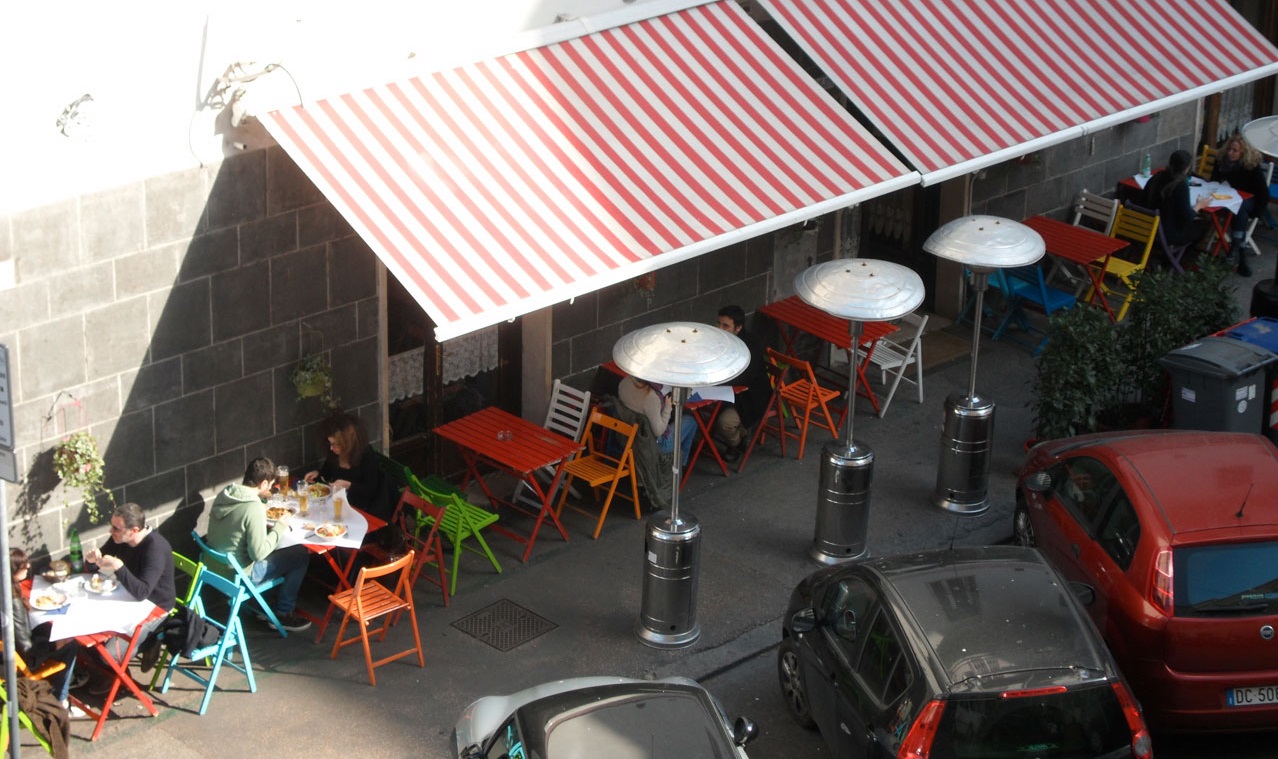description
Piazza del Popolo
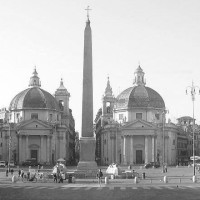 The three main arteries of Rome city center, Via del Babuino, Via Ripetta and Via del Corso meetthere in Piazza del Popolo. Representation of the papal Renaissance, old site of games, fairs, traditional shows and capital executions, the square is one of the most famous around the world. “Felici faustoque ingressui MDCLV” (For a happy and joyful entrance): this is the message Bernini carved on Porta del Popolo (the old Porta Flaminia) on the occasion of Christina of Sweden’s arrival in Rome, and today it receives millions of visitors who go to admire the historic and cultural magnificence of Rome every year. The two twin churches Santa Maria di Montesanto and Santa Maria dei Miracoli, Flaminio obelisk (the oldest one and the second highest of Rome), and the two Valadier fountains contribute to create a fascinating atmosphere on the square. And more, Santa Maria del Popolo church constructed where Nerone Emperor and his damned soul were buried, and the adjacent commercial stores, which are now vital components of the square, anciently attended by beloved personalities of Rome’s history as Trilussa, Guttuso and Pasolini, who make Piazza del Popolo the cultural emblem of the “romanity”. From Piazza del Popolo , crossing all Via del Corso you can reach all the main touristic spots of the city: Piazza Colonna, Montecitorio, Galleria Umberto Sordi, Trevi Fountain, Piazza Navona, Pantheon, Campo dei Fiori, Piazza Venezia and Piazza del Campidoglio.
The three main arteries of Rome city center, Via del Babuino, Via Ripetta and Via del Corso meetthere in Piazza del Popolo. Representation of the papal Renaissance, old site of games, fairs, traditional shows and capital executions, the square is one of the most famous around the world. “Felici faustoque ingressui MDCLV” (For a happy and joyful entrance): this is the message Bernini carved on Porta del Popolo (the old Porta Flaminia) on the occasion of Christina of Sweden’s arrival in Rome, and today it receives millions of visitors who go to admire the historic and cultural magnificence of Rome every year. The two twin churches Santa Maria di Montesanto and Santa Maria dei Miracoli, Flaminio obelisk (the oldest one and the second highest of Rome), and the two Valadier fountains contribute to create a fascinating atmosphere on the square. And more, Santa Maria del Popolo church constructed where Nerone Emperor and his damned soul were buried, and the adjacent commercial stores, which are now vital components of the square, anciently attended by beloved personalities of Rome’s history as Trilussa, Guttuso and Pasolini, who make Piazza del Popolo the cultural emblem of the “romanity”. From Piazza del Popolo , crossing all Via del Corso you can reach all the main touristic spots of the city: Piazza Colonna, Montecitorio, Galleria Umberto Sordi, Trevi Fountain, Piazza Navona, Pantheon, Campo dei Fiori, Piazza Venezia and Piazza del Campidoglio.
Pincio and Villa Borghese
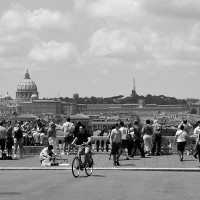 The most famous park of the Capital introduces itself on the map in this way, as a big green lung. Although it is only on third position for extension after Villa Doria Pamphili and Villa Ada, Villa Borghese it is for sure the most lively and loved park in Rome. It is a park characterized by multiple aspects. It is able to offer different attractions and amusements; it is appreciated by people who love walking and running outdoors, by families who gather on the grass around coloured picnics, by art lovers who appreciate the presence of several museums: starting from the big Galleria d’Arte Moderna to the singular Museo Etrusco,and from the Museo Carlo Bilotti Collection to the flagship of the park represented by Borghese Museum and Gallery, where it is possible to visit one of the most important art gallery in Rome and the wonderful Bernini’s sculptures. Within the park you can find a huge zoological garden called Bioparco, which hosts different types of animals attracting thousands of visitors every year, and also a Victorian style theatre, the Globe Theatre, just identical to the one in London, which offers a very rich theatre season during the summer. But the big green oasis has not finished its attractions yet: children can enjoy themselves in the game room dedicated to them called Casina Raffaello, Cinema lovers have a space created on purpose for them, Casa del Cinema, and last, Piazza di Siena horse show takes place during springtime with the traditional ritual of Carosello dei Carabinieri.
The most famous park of the Capital introduces itself on the map in this way, as a big green lung. Although it is only on third position for extension after Villa Doria Pamphili and Villa Ada, Villa Borghese it is for sure the most lively and loved park in Rome. It is a park characterized by multiple aspects. It is able to offer different attractions and amusements; it is appreciated by people who love walking and running outdoors, by families who gather on the grass around coloured picnics, by art lovers who appreciate the presence of several museums: starting from the big Galleria d’Arte Moderna to the singular Museo Etrusco,and from the Museo Carlo Bilotti Collection to the flagship of the park represented by Borghese Museum and Gallery, where it is possible to visit one of the most important art gallery in Rome and the wonderful Bernini’s sculptures. Within the park you can find a huge zoological garden called Bioparco, which hosts different types of animals attracting thousands of visitors every year, and also a Victorian style theatre, the Globe Theatre, just identical to the one in London, which offers a very rich theatre season during the summer. But the big green oasis has not finished its attractions yet: children can enjoy themselves in the game room dedicated to them called Casina Raffaello, Cinema lovers have a space created on purpose for them, Casa del Cinema, and last, Piazza di Siena horse show takes place during springtime with the traditional ritual of Carosello dei Carabinieri.
Piazza di Spagna
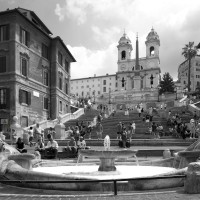 The square, called Spagna because of the presence of the Embassy of Spain in Vatican, is located down the Pincio Hill and it is decorated in the centre with the singular Fontana della Barcaccia by Pietro Bernini, Gianlorenzo’s father. The fountain was built to remember a dramatic flood of the city caused by the Tiber overflow. The marvel that however surprises people who visit Piazza di Spagna for the first time,it is all for the spectacular staircase, created by F. De Sanctis and A. Specchi (1721 – 1725), and it makes the square the highest urban creation in Rome during the XVIII century. On the right corner of the staircase there is the house of the English poet John Keats, where he lived and died in 1821, that today it has been transformed into a museum dedicated to his memory and the one of his friend Percy Bysshe Shelley, full of books and memorabilia of the English Romanticism. On the left corner there is instead the Babington’s tearoom founded in 1893. On the side next to Via Frattina the Propaganda Fide building rises, property of the Vatican. In front of its façade, planned by Bernini (the lateral façade is instead by Borromini), the Immacolata Concezione column rises up, which was built two years after the dogma proclamation. Climbing all the stairs of the staircase you can reach the square above where the magnificent façade and the twin bell towers of Trinità dei Monti Church emerge, which was built by the French government in order that the believers resident in Rome had their own ritual site. Inside the church you can admire two frescos (Assumption and Deposition) by Daniele Volterra (XVI century). The space in front of the church offers a beautiful view of the staircase and of Via Condotti, and a panoramic glimpse of the city where San Carlo al Corso and San Pietro cupolas dominate.
The square, called Spagna because of the presence of the Embassy of Spain in Vatican, is located down the Pincio Hill and it is decorated in the centre with the singular Fontana della Barcaccia by Pietro Bernini, Gianlorenzo’s father. The fountain was built to remember a dramatic flood of the city caused by the Tiber overflow. The marvel that however surprises people who visit Piazza di Spagna for the first time,it is all for the spectacular staircase, created by F. De Sanctis and A. Specchi (1721 – 1725), and it makes the square the highest urban creation in Rome during the XVIII century. On the right corner of the staircase there is the house of the English poet John Keats, where he lived and died in 1821, that today it has been transformed into a museum dedicated to his memory and the one of his friend Percy Bysshe Shelley, full of books and memorabilia of the English Romanticism. On the left corner there is instead the Babington’s tearoom founded in 1893. On the side next to Via Frattina the Propaganda Fide building rises, property of the Vatican. In front of its façade, planned by Bernini (the lateral façade is instead by Borromini), the Immacolata Concezione column rises up, which was built two years after the dogma proclamation. Climbing all the stairs of the staircase you can reach the square above where the magnificent façade and the twin bell towers of Trinità dei Monti Church emerge, which was built by the French government in order that the believers resident in Rome had their own ritual site. Inside the church you can admire two frescos (Assumption and Deposition) by Daniele Volterra (XVI century). The space in front of the church offers a beautiful view of the staircase and of Via Condotti, and a panoramic glimpse of the city where San Carlo al Corso and San Pietro cupolas dominate.
Via dei Fori Imperiali
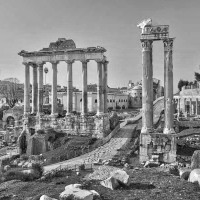 Fori Imperiali, located in the street with the same name in a suggestive position between Anfiteatro Flavio (better known as Colosseo) and Piazza Venezia, represent one of the most important touristic place of the Capital and of the whole world. During the ancient imperial Rome they represented the main place of the public and private life and visiting them it is possible to go back to the most glorious era of the Caput Mundi. From the entrance, located in Via dei Fori Imperiali, you can enter the area and you can immediately bump intothe ruins of Caesar Temple, from where you can easily reach Piazza del Foro, the ancient heart of the city life, whose center it is characterized by Colonna di Foca. A little bit further you can find the ruins of Settimio Severo Arch, of the Concordia Temple, of Vespasiano’s one and Saturno’s one. Proceeding further you can also find August Temple, Massenzio Basilica (also called Costantino’s), the ruins of Santa Maria Antiqua Church, House of the Vestal, Santa Francesca Romana Church, Tito Arch, Orti Farnesiani, August House, Domus Flavia, where anciently lived the Emperors, and Palatino Stadium.
Fori Imperiali, located in the street with the same name in a suggestive position between Anfiteatro Flavio (better known as Colosseo) and Piazza Venezia, represent one of the most important touristic place of the Capital and of the whole world. During the ancient imperial Rome they represented the main place of the public and private life and visiting them it is possible to go back to the most glorious era of the Caput Mundi. From the entrance, located in Via dei Fori Imperiali, you can enter the area and you can immediately bump intothe ruins of Caesar Temple, from where you can easily reach Piazza del Foro, the ancient heart of the city life, whose center it is characterized by Colonna di Foca. A little bit further you can find the ruins of Settimio Severo Arch, of the Concordia Temple, of Vespasiano’s one and Saturno’s one. Proceeding further you can also find August Temple, Massenzio Basilica (also called Costantino’s), the ruins of Santa Maria Antiqua Church, House of the Vestal, Santa Francesca Romana Church, Tito Arch, Orti Farnesiani, August House, Domus Flavia, where anciently lived the Emperors, and Palatino Stadium.
Museo Maxxi
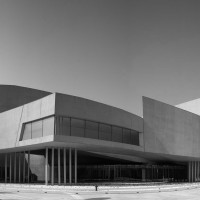 In the district called Flaminio, within the area of Montello barracks, the Anglo-Iraqi architect Zaha Hadid, chosen among 273 candidates coming from all over the world, planned the MAXXI, the National Museum for the XXI century Arts. A horizontal developed complex conceived as a “delta with different rivers”: eight longitudinal volumes, stranded and flexed one with another, which occupy a 30 thousands square meters area. The inner spaces are dedicated to the contemporary creativity and thought as gatherers for culture, experimentation, study and research.
In the district called Flaminio, within the area of Montello barracks, the Anglo-Iraqi architect Zaha Hadid, chosen among 273 candidates coming from all over the world, planned the MAXXI, the National Museum for the XXI century Arts. A horizontal developed complex conceived as a “delta with different rivers”: eight longitudinal volumes, stranded and flexed one with another, which occupy a 30 thousands square meters area. The inner spaces are dedicated to the contemporary creativity and thought as gatherers for culture, experimentation, study and research.
Foro Italico
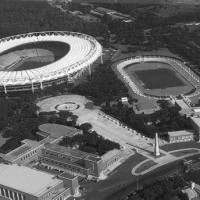 Foro Italico, originally called Foro Mussolini, it is a huge sport complex located between Monte Mario’s slopes and the Tiber. Conceived in order to connect sport disciplines and ideological education, it was used as a scenery for the celebrating demonstrations of the regime. The varied bodies of Foro Italico are stylistically inspired by the motifs of the classic Monumentalism and the Italian Rationalism. The projectidealized and realized by Enrico Del Debbio between 1927 and 1933 with the revision of Luigi Moretti, and completed between 1956 and 1968, today it has been still modified and its original profile has been changed. The first works of the architectural complex were Accademia della Musica (today the building of ISEF and location of RAI Auditorium), Fencing Academy, Male Fascist Academy of Physical Education, Stadio dei Cipressi and Stadio dei Marmi, decorated with statues representing the different sport activities. The main entrance of Foro Italico is located South-East, in front of Duca d’Aosta bridge where on a wide boulevard totally mosaicked with black and white patterns, a huge Carrara marble obeliskrises up. For the 1960 Olympics, the Olympic Stadium and the Swimming one were added. Nowadays the Foro is still the flagship for the sport in Rome: the Olympic Stadium for soccer matches, Stadio dei Marmi for athletics, the Swimming Stadium and the Tennis one, respectively for the International competitions of swimming and tennis. Furthermore, Centrale Live Foro Italico hosts concerts and extraordinary events.
Foro Italico, originally called Foro Mussolini, it is a huge sport complex located between Monte Mario’s slopes and the Tiber. Conceived in order to connect sport disciplines and ideological education, it was used as a scenery for the celebrating demonstrations of the regime. The varied bodies of Foro Italico are stylistically inspired by the motifs of the classic Monumentalism and the Italian Rationalism. The projectidealized and realized by Enrico Del Debbio between 1927 and 1933 with the revision of Luigi Moretti, and completed between 1956 and 1968, today it has been still modified and its original profile has been changed. The first works of the architectural complex were Accademia della Musica (today the building of ISEF and location of RAI Auditorium), Fencing Academy, Male Fascist Academy of Physical Education, Stadio dei Cipressi and Stadio dei Marmi, decorated with statues representing the different sport activities. The main entrance of Foro Italico is located South-East, in front of Duca d’Aosta bridge where on a wide boulevard totally mosaicked with black and white patterns, a huge Carrara marble obeliskrises up. For the 1960 Olympics, the Olympic Stadium and the Swimming one were added. Nowadays the Foro is still the flagship for the sport in Rome: the Olympic Stadium for soccer matches, Stadio dei Marmi for athletics, the Swimming Stadium and the Tennis one, respectively for the International competitions of swimming and tennis. Furthermore, Centrale Live Foro Italico hosts concerts and extraordinary events.
Auditorium Renzo Piano
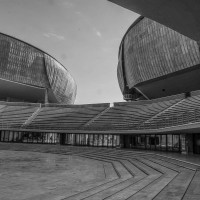 The Auditorium of Rome is a multifunction complex dedicated to the music, which contributes to enrich the already huge heritage of the Eternal City. The site chosen for the construction of the Auditorium is located on the light plain which extends between the Tiber bank and Parioli hill, between Villaggio Olimpico, built for the 1960 Olympics, and Palazzo dello Sport, and Flaminio Stadium, planned by Pierluigi Nervi. The area so decentralized has the advantage to be able to receive and easily manage a big incoming of public (thanks to the close infrastructures already existing) but also the one to occupy a space which has represented for a long time a sort of artificial rift, a “hole” in the city. Città della Musica becomes in this way a new urban element . The rift is now covered by a around 30000 square meters park, where 400 trees have been planted. The lush vegetation which works as a connection between the roman neighbourhood Flaminio and the adjacent Villa Glori, opens in order to leave some space to the amphitheatre, a urban focus which introduces a fourth hall outdoors, designed for shows and concerts, where around 3000 spectators can find a seat. The complex also comprehends different spaces for commercial, recreational, study and exhibition activities.
The Auditorium of Rome is a multifunction complex dedicated to the music, which contributes to enrich the already huge heritage of the Eternal City. The site chosen for the construction of the Auditorium is located on the light plain which extends between the Tiber bank and Parioli hill, between Villaggio Olimpico, built for the 1960 Olympics, and Palazzo dello Sport, and Flaminio Stadium, planned by Pierluigi Nervi. The area so decentralized has the advantage to be able to receive and easily manage a big incoming of public (thanks to the close infrastructures already existing) but also the one to occupy a space which has represented for a long time a sort of artificial rift, a “hole” in the city. Città della Musica becomes in this way a new urban element . The rift is now covered by a around 30000 square meters park, where 400 trees have been planted. The lush vegetation which works as a connection between the roman neighbourhood Flaminio and the adjacent Villa Glori, opens in order to leave some space to the amphitheatre, a urban focus which introduces a fourth hall outdoors, designed for shows and concerts, where around 3000 spectators can find a seat. The complex also comprehends different spaces for commercial, recreational, study and exhibition activities.
Ponte della Musica
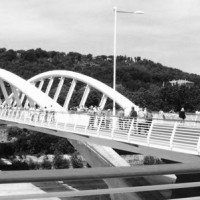 Ponte della Musica connects Flaminio neighbourhood with Della Vittoria neighbourhood. Coming from Via Guido Reni, where the MAXXI is,you can reach Piazza Gentile da Fabriano then you can arrive at Lungotevere Maresciallo Cadorna. The bridge has been built by the English studio Buro Happold Engineers, according to the Powell-Williams Architects project, which together won the international contest, announced in 2000, for the new work on the Tiber. The bridge is made of steel and concrete, 190 meters length and 22 meters wide. The wooden lateral staves and some architectural elements give the feeling of walking on a ship bridge. The official opening of Ponte della Musica occurred on May 2011.
Ponte della Musica connects Flaminio neighbourhood with Della Vittoria neighbourhood. Coming from Via Guido Reni, where the MAXXI is,you can reach Piazza Gentile da Fabriano then you can arrive at Lungotevere Maresciallo Cadorna. The bridge has been built by the English studio Buro Happold Engineers, according to the Powell-Williams Architects project, which together won the international contest, announced in 2000, for the new work on the Tiber. The bridge is made of steel and concrete, 190 meters length and 22 meters wide. The wooden lateral staves and some architectural elements give the feeling of walking on a ship bridge. The official opening of Ponte della Musica occurred on May 2011.
Trastevere
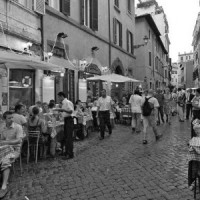 Trastevere is the emblem neighbourhood of the roman spirit. Protected by Gianicolo Hill, it has a unique structure, made of cobblestones alleys, beautiful and animated squares, small shops, splendid houses. A urban scenic design that invites people to dive in the past. That is the reason why many of the legends and traditions of Rome had their origin here. At any time of the day and night Trastevere introduces itself always welcoming, animated and lively. During the day its alleys are animated by small shops business, and at night it changes into the biggest heart of traditional restaurants, trattorias, bars and taverns of the city. Any name? La Sora Lella, Il Duca, and why not La Parolaccia, historic tavern where the employees are authorized to insult customers for general entertainment.
Trastevere is the emblem neighbourhood of the roman spirit. Protected by Gianicolo Hill, it has a unique structure, made of cobblestones alleys, beautiful and animated squares, small shops, splendid houses. A urban scenic design that invites people to dive in the past. That is the reason why many of the legends and traditions of Rome had their origin here. At any time of the day and night Trastevere introduces itself always welcoming, animated and lively. During the day its alleys are animated by small shops business, and at night it changes into the biggest heart of traditional restaurants, trattorias, bars and taverns of the city. Any name? La Sora Lella, Il Duca, and why not La Parolaccia, historic tavern where the employees are authorized to insult customers for general entertainment.
Saint Peter’s Basilica
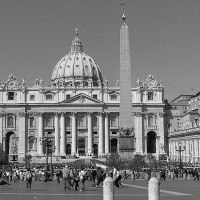 The majesty of the seventeenth-century façade by Carlo Maderno gives the idea of the colossal dimensions of Saint Peter’s Basilica, still nowadays one of the biggest churches around the world. The early Saint Peter’s Basilica, a building comparable to the current one for its dimensions, was constructed around 320 by Emperor Constantine on the site where Apostle Pietrowas buried according to the tradition. During centuries and varied pontificates that long process began and in around two hundred years and with the contribution of numerous artists (Bramante, Michelangelo, Bernini) it would have brought to the complete renewal of the early Constantinian Basilica. The cupola designed by Michelangelo surprises for dimensions and harmony, features that you can appreciate thanks to the tiring but gratifying climb that lets people admire from closer both the interior and the exterior. Among the numerous masterpieces, absolutely not to be missed Pietà di Michelangelo, the work that astonished during centuries for technique and emotionality. A splendid colonnade of 284 Doric order columns and 88 Tivoli travertine pillars surround Saint Peter’s Basilica, as it would like to receive in a symbolic embrace the believers visiting. The splendid architecture of the colonnade was commissioned by Pope Alessandro VII Chigi to Bernini, who put the four rows of 284 columns in aparticular position, whose diameter he gradually increased, being able in this way to keep unvaried the proportional relations among the spaces and the columns also in the external rows. Thanks to this expedient, the spectator can see the colonnade as composed by only one row of columns reaching the porphyry plates on the obelisk’s side.
The majesty of the seventeenth-century façade by Carlo Maderno gives the idea of the colossal dimensions of Saint Peter’s Basilica, still nowadays one of the biggest churches around the world. The early Saint Peter’s Basilica, a building comparable to the current one for its dimensions, was constructed around 320 by Emperor Constantine on the site where Apostle Pietrowas buried according to the tradition. During centuries and varied pontificates that long process began and in around two hundred years and with the contribution of numerous artists (Bramante, Michelangelo, Bernini) it would have brought to the complete renewal of the early Constantinian Basilica. The cupola designed by Michelangelo surprises for dimensions and harmony, features that you can appreciate thanks to the tiring but gratifying climb that lets people admire from closer both the interior and the exterior. Among the numerous masterpieces, absolutely not to be missed Pietà di Michelangelo, the work that astonished during centuries for technique and emotionality. A splendid colonnade of 284 Doric order columns and 88 Tivoli travertine pillars surround Saint Peter’s Basilica, as it would like to receive in a symbolic embrace the believers visiting. The splendid architecture of the colonnade was commissioned by Pope Alessandro VII Chigi to Bernini, who put the four rows of 284 columns in aparticular position, whose diameter he gradually increased, being able in this way to keep unvaried the proportional relations among the spaces and the columns also in the external rows. Thanks to this expedient, the spectator can see the colonnade as composed by only one row of columns reaching the porphyry plates on the obelisk’s side.
Vatican Museums
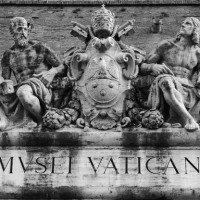 The magnificent and huge Vatican Museums represent one of the biggest and interesting museum complex around the world. This is just the reason why the queues at the entrance are very long, above all during the high season periods as Christmas, Easter and during the springtime. With a little bit of patience, tourists will be paid for sure in the interior! It is better to book the ticket on line or directly the visit with the guide,and you will save time and avoid the long queues at the entrance. The Vatican Museums complex includes inside varied museums: Museo Pio Clementino, Museo Chiaramonti, Museo Gregoriano Etrusco, Museo Gregoriano Egizio, Museo Gregoriano Profano, Museo Pio Cristiano, Museo Missionario Etnologico, Collezione d’Arte Religiosa Moderna, Gallerie Superiori, Museo della Biblioteca Vaticana, Pinacoteca and of course the incomparable Sistine Chapel. One day it is not enough to visit all of them, therefore it would be better to wear comfortable clothes and decide from the beginning what you would like to visit first. The last Sunday of each month the museums will be open and for free. From our B&B it is possible to reach Sain Peter’s Basilica and the Vatican Museums with the bus number 982. It is 700 meters walking from Via Giovanni Battista Tiepolo, direction Quattro Venti station, then you get off after 2 stops at Roma San Pietro; or with the tram number 2 direction Piazzale Flaminio, you get off at Piazzale Flaminio and take the underground A (Metro A) direction Battistini,and you get off at Ottaviano stop (from Flaminio just one stop). From Ottaviano just few minutes walking and you can reach your destination.
The magnificent and huge Vatican Museums represent one of the biggest and interesting museum complex around the world. This is just the reason why the queues at the entrance are very long, above all during the high season periods as Christmas, Easter and during the springtime. With a little bit of patience, tourists will be paid for sure in the interior! It is better to book the ticket on line or directly the visit with the guide,and you will save time and avoid the long queues at the entrance. The Vatican Museums complex includes inside varied museums: Museo Pio Clementino, Museo Chiaramonti, Museo Gregoriano Etrusco, Museo Gregoriano Egizio, Museo Gregoriano Profano, Museo Pio Cristiano, Museo Missionario Etnologico, Collezione d’Arte Religiosa Moderna, Gallerie Superiori, Museo della Biblioteca Vaticana, Pinacoteca and of course the incomparable Sistine Chapel. One day it is not enough to visit all of them, therefore it would be better to wear comfortable clothes and decide from the beginning what you would like to visit first. The last Sunday of each month the museums will be open and for free. From our B&B it is possible to reach Sain Peter’s Basilica and the Vatican Museums with the bus number 982. It is 700 meters walking from Via Giovanni Battista Tiepolo, direction Quattro Venti station, then you get off after 2 stops at Roma San Pietro; or with the tram number 2 direction Piazzale Flaminio, you get off at Piazzale Flaminio and take the underground A (Metro A) direction Battistini,and you get off at Ottaviano stop (from Flaminio just one stop). From Ottaviano just few minutes walking and you can reach your destination.

